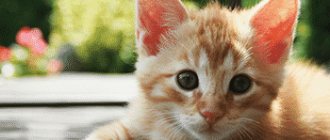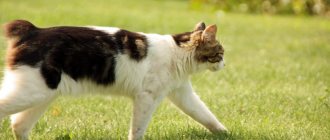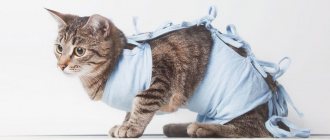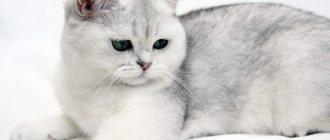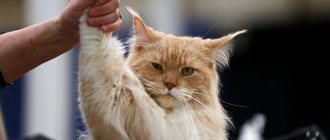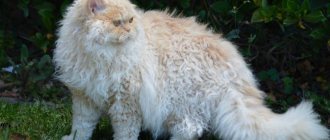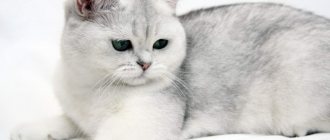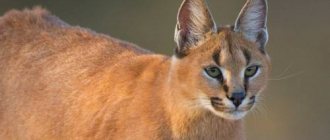All Maine Coons are unusual cats, since few other breeds of domestic purrs can compare with them in size. And the unusual ears with tassels like those of a lynx and the shape of the muzzle characteristic of wild cats make them a completely unique breed. But among them there are also those representatives of the breed who could rightfully be called unique animals. And these are Maine Coon Polydacts. But why are these cats so unusual and why is there no other breed similar to them in the world?
Concept
The phenomenon of polydactyly in itself is not unique. It happens not only in animals, but also in people. Translated from Greek, this word means “many fingers.” And, in fact, polydacty is nothing more than a gene mutation in which more fingers are formed on the limbs of a kitten during intrauterine development than is usually the case in other individuals of this species. Polydactyly is quite common and has existed for a long time, but as a phenomenon, it was recognized and studied only in the 19th century.
How does it manifest itself in Maine Coons? Regular cats have five toes on their front limbs and four on their hind limbs. The polydactyl Maine Coon has one or even several “extra” toes on its paws, which is why they appear wider and shaped like a mitten with the big toe set to the side.
Most often, “additional” phalanges are found on the front paws of the Maine Coon; they are also called six-toed.
Cats with normal front paws and five or more toes on their hind paws are much less common.
Nature and features of the anomaly
Polydactyly, or polydactyly , is an anatomical anomaly that consists of the presence of extra fingers.
Polydactyly is transmitted genetically
It is customary to distinguish the following forms of manifestation of polydactyly:
- preaxial – another thumb (typical of multi-toed cats);
- postaxial – extra little finger (more common in people with polydactyly).
A polydactyl cat does not have problems with the musculoskeletal system; this does not prevent the kitten from leading a full life.
The extra finger is only noticeable visually - the kitten's paws resemble mittens - but this does not interfere with the normal development of the baby.
Photo
Photo of the manifestation of a gene mutation in cats of this breed.
History of mutations
Scientists still don’t know why Maine Coons developed the polydactyly gene, which is generally unusual for cats. There is an assumption that this was not a failure in the genetic program, but the result of evolution and natural selection. Indeed, for Maine Coons, who lived for a long time almost in wild conditions, in addition to hunting instincts and a large, powerful physique, wide, stable and strong paws were also a vital necessity.
They helped the cats avoid falling into snowdrifts when moving through loose snow, gave them extra grip when climbing trees, and allowed them to more deftly snatch fish from streams.
Subsequently, apparently, people consciously consolidated this feature of the polydactyl Maine Coons when they made these cats their companions on long sea voyages.
For the cats that lived on ships, extra toes gave them stability during rocking and allowed them to hunt rodents more successfully. Such cats were highly valued and were considered symbols of good luck among sailors.
Talisman for good luck
Legends say that those with a large number of fingers and mustaches bring happiness to their owners.
Their ancestors are considered to be Maine Coons, natives of New England, Wales and Canada. Thanks to their unique tenacious paws, they easily move through loose snow and are valued as excellent hunters. History has preserved legends that polydacts, at critical moments of hungry years, caught fish with their tenacious paws and then brought them to their owners.
For a long time they enjoyed special honor and respect among sailors who firmly believed that multi-toed cats bring unprecedented luck. The rapid spread of polydacts in America, Nova Scotia and Norway occurred, presumably, with the participation of merchant marine sailors, who carefully looked at how many fingers cats had, and selected multi-fingered ones for long journeys as travel companions. Thanks to the increased number of claws, they deftly climbed ropes, skillfully balanced on the deck during a storm, and were excellent at catching ship rats - protecting the ship's provisions from rodents.
Character
People who know these cats claim that they have “human” character traits.
Cats with polydactyly are very intelligent and intelligent.
These are affectionate and very affectionate animals with a friendly disposition.
At the same time, they also have wild instincts: polydacts are considered more dexterous and skillful hunters than ordinary cats. They are playful and have a unique sense of humor.
Polydactyl Maine Coons often make a wide variety of sounds when communicating with their owner. In their voice, interestingly, sometimes you can even hear chirping or even an almost real bird trill, although, usually, they meow and purr.
Most Polydact Maine Coons love water.
And some of them even have the surprising habit for a cat of washing their food in water using their wide front paws.
KotemotFor those who love cats
History of the appearance of the breed Information about the time of breeding of the first individuals of this unusual breed of cats, unfortunately, could not be found. Only the name gives us at least some guidance on where to look for ancestors. Currently, cats of this breed are most common on the east coast of the United States. There is also evidence of polydactyl cats living in Great Britain, in the southwest of the country.
One of the official versions of the origin of multi-toed cats says: the first individuals appeared on the planet as a result of evolutionary processes. Man did not have a hand in such a mixing of genes and the birth of a new organism. He could only preserve and distribute already born individuals naturally or through artificial migration around the world.
Other sources claim that the breed originated in Boston, Massachusetts, North America. The spread of cats to other continents occurred with the help of people in various ways. They say that cats were highly valued on sea ships for their excellent ability to catch mice. Some rumors say that many sailors considered this breed to “bring goodness and success on long journeys.” When the breed of multi-toed cats was officially approved, the question arose of when to start counting. To simplify registration, the origin of the American Polydactyl breed is counted from the date of the beginning of the trade exchange between Great Britain and Boston.
In troubled times in Europe, when the Inquisition was raging there and anyone could be called a heretic and burned alive, there was a brutal extermination of multi-toed cats because of their appearance. It was the structure of the body that gave the Holy Inquisition every right to dub this poor animal “the devil’s spawn” and destroy them with agility and zeal. Centuries later, it was not possible to compensate for the loss of the cat breed in Europe. Therefore, they are currently quite rare on this continent.
Appearance
For these unusual animals, multi-toed cats from America, a characteristic feature is a slightly curved, awkwardly wide head. Its outline can be compared to a ripe pear. The eyes are medium-sized and set deep in the skull. The breed has wide brow ridges and thick eyebrows.
Nature worked its magic with this animal and changed their ears. Evolutionary development has made the ears shifted, for the most part, to the occipital region of the cat’s head and of a fairly large size. Our “world of creation” at the birth of any organism, having joked with it, does not forget about the most basic for the life of its brainchild. This breed of cats was given a strong physique and a powerful skeleton. The breed's limbs are thick in shape, medium in length, with strong paws. The toes are also medium in size. The tail is naturally always carried down and very short.
The color of the American cat's coat turned out to be double - brown-black tabby. A frequently encountered color pattern was a combination of small spots on the animal’s fur with tiny rosettes, or without them at all.
You cannot ignore the most important feature of this breed - multi-toed paws. Analyzing this phenomenon from the point of view of scientific medicine, we can call this polydactylism an anomalous phenomenon in the structure of the animal’s body, which has its own name - “polydactyly” (in Latin “polydactylism”). The anomaly appears at the birth of individuals of this breed and is passed on from offspring to offspring at the genetic level. Perhaps the ancestors of the multi-toed cat needed such changes in their paws. Evolutionary development changed all living organisms, improving them over time and removing everything unnecessary. Apparently, evolution has failed in this breed, which can be scientifically called “an inherited mutation of the paws of the cat breed.” After all, ordinary, non-deviant breeds have 18 toes, 5 toes on each front paw and 4 on each hind paw. As for the American multi-toed cat, its paws have up to 7 toes on the front or hind paws.
Thus, this anomaly leads to the birth of individuals of the breed with more toes than ordinary cats. The mutation can appear on just one, or on all of the animal’s paws at once. Individual multi-toed cats with the largest number of toes are even listed in the Guinness Book of Records.
Character of the breed
In ancient times, the Holy Inquisition, calling these cats “children of Satan,” supported this definition only by external signs of the animal’s body. In fact, American polydactyl cats have a calm disposition. Throughout their lives, cats are never in a hurry. The tactics of behavior of animals of the breed are very soft and unobtrusive, and the smoothness of movements adds a feeling of special affection and tenderness. Among the individuals of the breed there are very shy, modest individuals. But with all the calmness, cats will never miss their opportunity if someone wants to play with them.
The character of these animals is more similar to that of dogs. Multi-toed cats, even with their growl, whether playing with a person or among themselves, are very reminiscent of the sounds of dogs. The voices of this cat breed are quiet but firm. It is useless to try to get extra sounds from them. But American cats with multi-toed paws purr melodiously and quite loudly. They have a tendency to dominate the place where they live.
Features of maintenance and care
The main thing in caring for this breed is that a multi-toed cat of American origin feels comfortable and cozy only in the house or dwelling in which it is the only pet. They absolutely do not tolerate competition of any kind. They won’t start conflicts, but you can’t even dream of friendship with other pets.
Living in apartments, cats are absolutely indifferent to its upper levels (high shelves, top of cabinets, etc.). Multi-toed cats have a great passion for fiddling with toys. I especially like the ritual of bringing something in the teeth to its owner. They tend to be leaders in the house or dwelling in which they constantly live. The American polydactyl cat will not miss an additional opportunity to show other residents in every possible way who is the real boss in the house.
By rewarding them with an external mutation, nature endowed multi-toed cats with a capacious mind. Loneliness and separation from the owner are destructive for this breed; they very quickly become attached to their owners. The general requirements for caring for this cat breed are quite simple. There are no special requirements for combing their fur; it is enough to do it once a week. Despite good health from birth, limb abnormalities still hinder cats and somewhat slow down their maturation.
Extra toes on a cat's paws require extra care. Their nails have to be trimmed a little more often than usual. If you fail to complete this procedure in time, you can injure your cat. American polydactyl cats easily tolerate changes in ambient temperature. During the cold season, their owner can be calm about their pet. Feeding animals of this breed does not have any special features. A distinctive feature of multi-toed cats is their unpretentiousness and calmness.
Possible medical problems
American polydactyl cats are in good health, but there are two important nuances. Cats take longer to learn to walk than their counterparts with regular paws. And they need to trim their claws regularly, since animals cannot grind them down.
Breed standard
- Body. Strong build, powerful limbs of medium length with dense paws. A distinctive feature is polydactyly.
- Head. Quite wide, slightly pear-shaped, slightly curved outline.
- Ears. Long, located towards the back of the head
- Wool. The length of the coat is medium, pronounced typing.
- Colors. The coat color is either brown or black tabby. Pattern - small spots with or without rosettes.
- Tail. Short, dropped down.
- Eyes. Planted deep, medium size. Eyebrows are clearly visible.
- Disqualification. Aggressive behavior.
- Flaws. Lack of polydactyls, too long tail, thin limbs
Advantages and disadvantages
Among the advantages of Maine Coons with polydactyly is their high intelligence.
As well as an affectionate and affectionate character.
They love water very much and the associated truly amazing and cute habit of washing their food before eating.
The unusual appearance of such an animal is also an advantage. After all, polydactyl cats and cats of this breed, in addition to “extra” fingers, also have such external breed characteristics as:
- large, powerful body with a wide chest and well-developed muscles;
- massive head with a strong and well-defined chin;
- large ears pointed at the top with tassels, like those of a lynx;
- large, bright and expressive eyes, predominantly blue.
The color of the polydactyl Maine Coon can be very diverse and is no different from the color of the standard breed variety.
The only disadvantages of polydacts include the impossibility of such animals participating in regular exhibitions, not allowing them to breed for breeding, as well as the highly developed hunting instincts of these cats.
Is it worth buying?
Some people are afraid to buy cats with extra toes.
They believe that this mutation could also negatively affect the health of such a kitten.
In fact, in humans, the polydactyly gene often accompanies many hereditary diseases.
But in cats, it only slightly changes their appearance. The Maine Coon Polydactus looks larger and more massive than ordinary cats, but he does not have any health problems associated with the polydactyl gene.
It is worth buying such a pet if the future owner does not care about exhibition awards and titles, as well as the participation of the Maine Coon in breeding.
Disadvantages and dangers of polydactyly
In some cases, polydactyly is caused by a gene that leads to the development of other pathologies in the animal. These are deformations of the limbs, improper development of bones, joint diseases, and ingrown claws. Then the animal requires qualified treatment.
One of the dangerous anomalies is the appearance of a three-phalanx thumb. Cats with this pathology often give birth to underdeveloped offspring. Their kittens may have deformed forearms, and therefore such animals are usually sterilized.
Famous fans
Such an amazing animal as the Maine Coon Polydactus could not help but attract the attention of prominent people, one of whom was the famous writer Ernest Hemingway. The island on which he lived and worked was inhabited by dozens of Maine Coon cats with extra toes. The ancestor of the island population and the writer’s main favorite was a white cat named Snowball, or, translated into Russian, Snowball. It is his descendants that are the numerous cats that still live in the writer’s house—the museum.
Another famous polydactyl Maine Coon is a cat named Slipper, who belonged to American President Theodore Roosevelt. This animal was the first of the cats that was allowed to live on the territory of the White House, and he was often present at meetings, press conferences and official receptions, where he was often the center of attention.
Breeding wide-footed cats
Broad-footed Maine Coon breeds are bred in nurseries based on breeding programs, where the corresponding gene is passed on between generations. To produce offspring with polydactyly, one parent must have a foot anomaly - then the birth of offspring with polydactyly is possible with a probability of 56% (not all kittens in the litter are polydactylic).
If you breed two wide-legged animals, the likelihood of having polydact kittens increases by another 20%. Mating, where one parent is a homozygous polydact, leads to the fact that the entire litter will be polydactyl.
Polydactyly in cats
The polydactyly gene behaves unpredictably. It is expressed differently in offspring, regardless of the combination of fingers of the parents. In contrast to other dominant genes, it manifests itself in different ways in both homo- and heterozygous forms.
Breeders of broad-toed cats continue to conduct statistical work, trying to discover more accurate information about the likelihood of producing multi-toed kitten offspring.
Be sure to read:
Caring for an amazing raccoon cat - Maine Coon
Official status
Currently, Maine Coons with polydactyly, although recognized by most European felinological organizations, are not allowed to participate in regular show classes. Maine Coons can only compete with each other.
Even if Maine Coons are polydactyly and participate in shows, they are not eligible to receive a championship title.
In addition, these cats are denied access to breeding. In America, polydactyly is treated less strictly: cats with excess toes registered in organizations such as ACFA, CFA, CFF, TICA are allowed for breeding.
Breeding and polydactyly
In the 80s of the last century, attitudes towards Maine Coons with extra fingers changed. Adherents appeared who bred polydacts in their nurseries. These kittens are in great demand. The reason is not only its charming appearance, but also its affectionate playful character.
Attitudes towards Maine Coons with extra toes are very different in Europe and America. In the United States, mutations are not given a negative meaning; cats are quite popular. It doesn't matter how many fingers a Maine Coon has. In Europe the attitude is different. There are very high standards for the characteristics and purity of the breed. Any differences and mutations are considered a defect and non-compliance with the requirement.
Official status of Maine Coons polydacts
Maine Coon polydacts received official recognition in 2008. Standards for polydactic individuals are currently being developed, and in the future they may have the right to compete for the champion title and prizes at exhibitions. Many organizations both in the United States and other countries recognize members of the breed with extra toes.
Some felinological systems (mainly in the USA) include mutated individuals in their registries.
A real struggle ensued for the recognition of polydacts. The MCBFA Association has determined the requirements of the standards and classification of polydactics. Now representatives of the international organization PolyStandard actively seeking their official recognition.
Currently, polydacts can only qualify as an experimental breed under the TICA system.
It is important to take the following into account. Because there are concerns that deviations may be extreme, limits have been set. So, a cat cannot have more than 7 toes on one paw.
Is it necessary to treat polydactyly in a pet?
Polydactyly does not negatively affect the physical condition of the cat or its character. Therefore, it is not a disease and does not require treatment. If the mutation manifests itself in the form of a pathology with deviations, then the animals do not survive to the age of one month simply because they cannot move normally.
Breeding
The polydactyly gene is autosomal dominant. That is, it is possible to get kittens with extra fingers only if one of their parents has this feature. In this case, the probability of polydacts appearing will be 40 - 50%.
The location of the fingers, their thickness and the shape of the paw are not inherited. In kittens they can be completely different from those of the polydactic parent.
It was also noticed that kittens born from one of the polydacts are stronger and more powerful than those born from standard parents. They have a wider chest and a more massive head.
